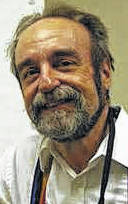
Recall from last week Immanuel Kant’s proposal that the Milky Way is a spinning disk held in place by a harmonious equilibrium between the motion of its spin, which made it want to flatten and fly apart, and the mutual gravity of the stars and planets which made them want to fall into the center.
In retrospect, Kant was stunningly correct, but no matter. He made his claim without any evidence, and that’s not how science works.
The problem was that there was no reliable way of determining the distance to the stars in our Milky Way or the fuzzy ovals that we have come to call galaxies but which were called “spiral nebulae” during the 19th century.
Perhaps the most skilled telescope maker and astronomical observer of all time, William Herschel, was undaunted by the distance problem. He simply made the critical (if erroneous) assumption that all stars were the same brightness. Thus, fainter stars were increasingly farther away than brighter stars, according to a strict set of Newtonian calculations.
He then observed thousands of stars and placed them in the Milky Way based on Newton’s brightness-distance law.
His 1785 drawing, available at https://www.astronomy.ohio-state.edu/ryden.1/ast162_7/hersch.gif, shows a flattened disk with “crooked branches,” a close, if crude, representation of our modern depiction of the Milky Way. Herschel also believed the Milky Way was a “detached nebula,” which opened up the possibility that other galaxies like the Milky Way existed, as Kant had proposed over 100 years before.
By 1845, British astronomer Lord Rosse added another vital clue to the Milky Way conundrum, although no one recognized it then.
He completed a reflecting telescope with an unprecedented diameter of 72 inches.
Rosse was particularly interested in the “starry nebulae,” mysterious, faint patches of light.
Rosse’s telescope revealed that some of the “nebulae” resolved into spirals resembling children’s pinwheels.
Rosse had uncovered a more profound mystery than the one he started with. The objects went from unidentifiable fuzzy patches to unidentifiable spirals. He still didn’t know what they were, and contemporary astronomers couldn’t figure it out either.
By the early 20th century, astronomers still assumed Herschel’s distance-brightness relationship. Jacobus Kapteyn used star images from astronomers worldwide to produce a flattened disk similar to — but somewhat more accurate than — the one Herschel had constructed over a century before.
Both images were flawed because intervening gas and dust among the stars absorbed some of the light they produced. Also, stars vary widely in their intrinsic brightness.
As a result, Kapteyn’s proposed Milky Way was much smaller than the Milky Way we know today. He also believed that when he mapped the Milky Way, he was mapping the entire universe. To Kapteyn, Rosse’s spiral nebulae were part of the Milky Way.
Over time, astronomers refined their ability to gauge the distance to the stars, and the familiar spiral shape of the Milky Way emerged. As telescopes got more powerful, more of the “spiral nebulae” began to reveal their spiral structure.
The fundamental structural similarity between the nebulae and the Milky Way seems obvious today, but it was hardly evident to 19th-century astronomers.
Thus, the questions about the Milky Way’s extent and structure remained. Did the Milky Way represent the whole universe? Did it include the spiral nebulae, which many astronomers believed to be part of the Milky Way? They were perhaps individual stars in the process of formation as gasses streamed into their central bulge.
That point of view came to be called the Kapteyn universe. During the early 20th century, one of its proponents was Harlow Shapley of Mount Wilson Solar Observatory.
Note Professor Shapley’s name. He was utterly wrong about the Milky Way. But as any scientist should, he freely admitted it and strove later to probe the Milky Way’s exact structure and our place in it.
The theory that the spiral nebulae were separate milky ways or “island universes” to use the common term at the time, also had its proponents. Notable among them was Heber Curtis of Lick Observatory.
That debate raged throughout the early 20th century. It culminated in the “Great Debate” between Shapley and Curtis at the National Academy of Sciences’ annual meeting on April 26, 1920.
More on the Great Debate next week.
Tom Burns is the former director of the Perkins Observatory in Delaware.
Tom Burns is the former director of the Perkins Observatory in Delaware.

